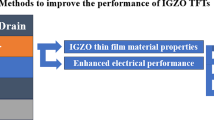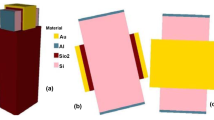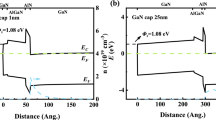Abstract
This article put forward a novel device structure of electrically doped tunnel field effect transistor to improve DC and RF performance with suppressed ambipolarity and gate leakage. For suppressing gate leakage and ambipolarity, gate underlapping has been presented, which does not significantly affect the Analog/RF parameters of the device. Further, for improving the device performance a novel initiative of implanting a T-shaped metal layer under gate electrode at source/channel interface with high-k dielectric material has been investigated in the proposed structure. In addition, optimization of gate and electrical drain underlapping is investigated in comparative manner for proposed structure.












Similar content being viewed by others
References
M. Lundstrom, Moore’s law forever? Science 299(5604), 210–211 (2003)
S. Bangsaruntip, G.M. Cohen, A. Majumdar, J.W. Sleight, Universality of short-channel effects in undoped-body silicon nanowire MOSFETs. IEEE Electron Device Lett. 31(9), 903–905 (2010)
International Technology Roadmap for Semiconductors (ITRS). [Online]. http://www.itrs2.net. Accessed 10 July 2000
S.O. Koswatta, M.S. Lundstrom, D.E. Nikonov, Performance comparison between p-i-n tunneling transistors and conventional MOSFETs. IEEE Trans. Electron Devices 56(3), 456–465 (2009)
Q. Zhang, W. Zhao, A. Seabaugh, Low-subthreshold-swing tunnel transistors. IEEE Electron Device Lett. 27(4), 297–300 (2006)
W. Cao et al., Subthreshold-swing physics of tunnel field-effect transistors. Nature 4(6), 067141 (2014)
N. Damrongplasit, C. Shin, S.H. Kim, R.A. Vega, T.J.K. Liu, Study of random dopant fluctuation effects in germanium-source tunnel FETs. IEEE Trans. Electron Devices 58(10), 3541–3548 (2011)
M. Graef, F. Hain, F. Hosenfeld, F. Horst, A. Farokhnejad, B. Iniguez, A. Kloes, Numerical analysis and analytical modeling of RDF in DG Tunnel-FETs, in Joint International EUROSOI Workshop and International Conference on Ultimate Integration on Silicon (2016), pp. 64–67. https://doi.org/10.1109/ULIS.2016.7440053
M. Graef, F. Hain, F. Hosenfeld, F. Horst, A. Farokhnejad, A. Kloes, B. Iguez, Comparative numerical analysis and analytical RDF-modeling of MOSFETs and DG Tunnel-FETs, in Mixed Design of Integrated Circuits and Systems 23rd International Conference (2016), pp. 47–51. https://doi.org/10.1109/MIXDES.2016.7529698
Y. Zhul, Y. Yel, Y. Caol, J. Hel, A. Zhangl, H. Hel, H. Wangl, C. Mal, Y. Hul, M. Chan, X. Zhu, Numerical study on effects of random dopant fluctuation in double gate tunneling FET. Electron Devices Solid State Circuits, 1–2 (2016). https://doi.org/10.1109/EDSSC.2013.6628040
M.J. Kumar, S. Janardhanan, Doping-less tunnel field effect transistor: design and investigation. IEEE Trans. Electron Devices 60(10), 3285–3290 (2013)
M. Kumar, S. Jit, Effects of electrostatically doped source/drain and ferroelectric gate oxide on subthreshold swing and impact ionization rate of strained-Si-on-insulator tunnel field-effect transistors. IEEE Trans. Nanotechnol. 14(4), 597–599 (2015)
A. Lahgere, C. Sahu, J. Singh, Electrically doped dynamically configurable field-effect transistor for low-power and high-performance applications. Electron. Lett. 51(16), 1284–1286 (2015)
H.-C. Lin, R. Lin, W. Wen-Fa, R.-P. Yang, M.-S. Tsai, T.-S. Chao, T.-Y. Huang, A novel self-aligned T-shaped gate process for deep submicron Si MOSFETs fabrication. IEEE Electron Device Lett. 19(4), 26–28 (1998)
P. Ranade et al., Work function engineering of molybdenum gate electrodes by nitrogen implantation. Electrochem. Solid State Lett. 4(11), G85–G87 (2001)
R.W. Johnson, A. Hultqvist, S.F. Bent, A brief review of atomic layer deposition: fundamentals to applications. Mater. Today 17(5), 236–246 (2017)
M. Putkonen et al., Thermal and plasma enhanced atomic layer deposition of SiO\(_2\) using commercial silicon precursors. Thin Solid Films 558, 93–98 (2014)
M. Putkonen et al., Low temperature silicon dioxide by thermal atomic layer deposition: investigation of material properties. J. Appl. Phys. 107, 064314 (2010)
J. Niinisto et al., Atomic layer deposition of HfO\(_2\) thin films exploiting novel cyclopentadienyl precursors at high temperatures. Chem. Mater. 19, 3319–3324 (2007)
K. Xu, A.P. Milanov et al., Atomic layer deposition of HfO\(_2\) thin films employing a heteroleptic hafnium precursor. Chem. Vap. Depos. 18, 27–35 (2012). https://doi.org/10.1002/cvde.201106934
T.W. Weidman et al., Atomic layer deposition of hafnium or zirconium alloy films. U.S. Patent, no. 9, pp. 236–467 (2016)
ATLAS Device Simulation Software, Silvaco Int., Santa Clara, CA, USA (2014)
A. Schenk, A model for the field and temperature dependence of SRH lifetimes in silicon. Solid State Electron 35(11), 1585–1569 (1992)
J. Zhuge, A.S. Verhulst, W.G. Vandenberghe, W. Dehaene, R. Huang, Y. Wang, G. Groeseneken, Digital-circuit analysis of short-gate tunnel FETs for low-voltage applications. Semicond. Sci. Technol. 26(8), 085001 (2011)
P. Chaturvedi, M. Jagadesh Kumar, Impact of gate leakage considerations in tunnel field effect transistor design. Jpn. J. Appl. Phys. 53(7), 1–21 (2014)
Y. Yang, X. Tong, L.-T. Yang, P.-F. Guo, L. Fan, Y.-C. Yeo, Tunneling field-effect transistor: capacitance components and modeling. IEEE Electron Device Lett. 31(7), 752–754 (2010)
Acknowledgements
The authors would like to thank the Science and Engineering Research Board, Department of Science and Technology, Government of India (established through an act of parliament), for providing the financial support to carry out this work. As this work has been implemented under the project Implementation of Sigma Delta Modulator Using Nanowire Electrically Doped Hetero Material Tunnel Field Effect Transistor (TFET) for Ultra Low Power Applications which is funded by this board.
Author information
Authors and Affiliations
Corresponding author
Rights and permissions
About this article
Cite this article
Yadav, S., Madhukar, R., Sharma, D. et al. A new structure of electrically doped TFET for improving electronic characteristics. Appl. Phys. A 124, 517 (2018). https://doi.org/10.1007/s00339-018-1930-9
Received:
Accepted:
Published:
DOI: https://doi.org/10.1007/s00339-018-1930-9




